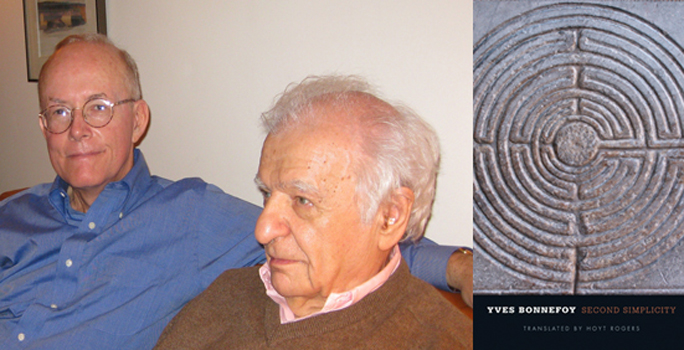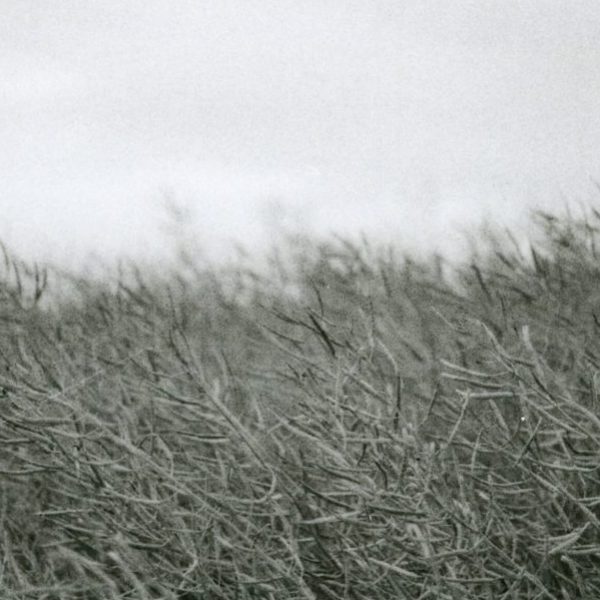Happy Birthday, Yves Bonnefoy: New Writing on Shakespeare

Hoyt Rogers, left; Yves Bonnefoy, right
Yves Bonnefoy, often acknowledged as France’s greatest contemporary poet, turns 89 today. Earlier this year, the publication of Second Simplicity: New Poetry and Prose, 1991-2011, translated from the French by Hoyt Rogers, exposed Bonnefoy‘s latest writings to an audience of English readers. Included in the volume are two unpublished fantasias on Hamlet— each a succinct tour de force that vividly reminds us of Bonnefoy‘s profound closeness to Shakespeare from his work as a translator in his own right. Bonnefoy has translated all the lyric poems, as well as a dozen of the plays; Hamlet was among the earliest in the series, dating back to 1957. A conversation between Bonnefoy and Rogers on translating work for the new volume is available on the Margellos World Republic of Letters website.
In honor of the writer’s birthday, we are pleased to bring you the first of these two fantasias: “First Sketch for a Staging of Hamlet” proposes an impossible stage-set, in a theater as vast and diffuse as a mountainside, which mirrors the boundlessness of the ideal reader’s mind. Bonnefoy‘s fundamental identity with Shakespeare also affords some clues to defining his late manner as a whole.
First Sketch for a Staging of Hamlet
This staging, they said, had only one aim: to stick to the requirements of the text.
For example, when the watchmen exchange their opening words, the director simply tried to make the night like what the soldiers feel on those ramparts, out in the cold. A cold that pervades the theater as well—if this place where we’re listening is a theater. The spectators who’re already here when I arrive are huddled in heavy clothes: sometimes they’re almost spread out on the ground, so I have to step with care in the crannies between their bodies. On the light-colored sand, I mostly see the wool of overcoats; and much less often, the silk of dresses. Actually, I’d say these men and women, along with a handful of children, must have gotten here a number of days ago—or rather nights ago. They’ve lit fires here and there: their ruddy smoke pierces the boundless dark. Some of these people are asleep; I hear their regular, peaceful breathing. But I come across others who’re on the lookout, and whose penetrating stares frighten me so much I hurry on. Far off, from time to time, I hear the kind of shouts we only let out in dreams. I walk gingerly, backtracking as I go, though always keeping my eyes trained on the stage.
The stage? It’s dimly lit, but I can still make out the towering rocks, the rain, and four or five men or women, milling around a table with a book on top. One of them picks it up and looks at the page it’s opened to. ‘‘I read,’’ he says: ‘‘Who’s there?’’ Around him, muddled cries. As it happens, the director’s other main goal is to grasp the text: in the first place, to follow each word literally, but also to unearth what each word means. How should he go about it, in the thick of this night? It seems to me that his assistants, vague beings who cluster around him, don’t agree with him or with each other. ‘‘Who’s there?’’ Admittedly, how can you know who’s there?
 ‘‘And what comes after that?’’ somebody exclaims. ‘‘Friends to this ground,’’ somebody else replies. At that, a third bends over and raises a big stone from the ground. He has a hard time lifting it; he elbows his friends aside and tries to toss it fairly far off. ‘‘If the actor threw this rock,’’ he asks, ‘‘would that have any meaning?’’ ‘‘Hold on,’’ a young woman answers him. ‘‘You are one of the actors, don’t forget, and the show has already started. It’s been going on for hours, for days.’’
‘‘And what comes after that?’’ somebody exclaims. ‘‘Friends to this ground,’’ somebody else replies. At that, a third bends over and raises a big stone from the ground. He has a hard time lifting it; he elbows his friends aside and tries to toss it fairly far off. ‘‘If the actor threw this rock,’’ he asks, ‘‘would that have any meaning?’’ ‘‘Hold on,’’ a young woman answers him. ‘‘You are one of the actors, don’t forget, and the show has already started. It’s been going on for hours, for days.’’
But all of a sudden, there’s a great hubbub in the theater. All over the place, people are standing up, stretching their limbs, and talking out loud. They’re on the move, since they’ve just realized the performance is going on elsewhere as well, elsewhere as much as here: for example, at this very moment, in a mountain chalet that can only be reached by climbing a narrow path, where snowfalls have left some puddles along the way. The chalet is one of those light wooden constructions, a bit like a Swiss cuckoo-clock—the kind big theaters liked to place upstage in the bel canto era. You’ll have to open the door and venture to look into this room, illumined by a table lamp; inside, you’ll see Hamlet insulting his mother. Gertrude? Yes, collapsed on a bed, her shoulders bared, her hair disheveled. She’s hiding her head with one of her hands. ‘‘O, speak to me no more,’’ she groans. What a shame—but who’s interested in her fate? News spreads that somewhat farther up on this same path, the director has taken another tack with Hamlet. This time there’s a noble, handsome facade made from stone, with columns at the top of the stairs. On the highest step, I—at any rate—see two unreadable beings; they struggle silently, bare palms against bare palms. When did this face-off begin, and how many hours, how many nights, will it persist? Is this ‘‘readiness’’? Is this the sad vow that whirls and burrows down, deep in the abyss of words? And above this vain combat: the wall of rock, the frigid wind.
There are so many other scenes! The spectators know very well they must set out to find them, even far away in what seem like moraines. Beneath snow-covered firs, they must boldly open doors— though behind them, heart-rending cries can sometimes be heard. The theater is as huge as the mountain. The theater is the mountain. Ophelia wanders around it barefoot. We watch her go by; we stand back. She’s all alone, humming to herself: her solitude is so immense . . .
What a lot of work, this staging of Hamlet! The set builder faces untold temptations, endless desires he must discard; but first he must understand them. For example: what should we make of this child who’s weeping at the edge of the road? An old sage in traveling dress— it’s Basho, always benevolent—stops beside the boy and lays his hand on his shoulder; he questions him, listens, nods his head, and walks on. And who’s this second young woman? Scantily clad, she feeds some large black birds in a kind of stable; in the shadows, we hear horses stamp, neighing now and then. We’re told that in this staging of Hamlet, the author himself has become an actor again, the actor he once was. He’s required to come toward her on a lengthy path, across the stones of time, the voices of space. He keeps moving closer, though we don’t know exactly where he is. Maybe he’ll appear at some point on the enormous stage, a hurricane lamp in his hands: and the mask on his face will be the words of poetry.
Excerpted from Second Simplicity: New Poetry and Prose, 1991-2011, by Yves Bonnefoy, translated by Hoyt Rogers. Copyright © 2011 by Yale University. All rights reserved.
Yves Bonnefoy has published nine major poetry collections, numerous studies of literature and art, and an extensive dictionary of mythology. He is a celebrated translator of Shakespeare, Yeats, Keats, and Leopardi, and his own work has been translated into scores of languages. Honored internationally by the highest literary awards, including the Kafka Prize and the European Prize for Poetry, he is often acknowledged as France’s greatest contemporary poet.
Hoyt Rogers translates literary works from the French, German, and Spanish. His translation of Bonnefoy’s The Curved Planks was published by Farrar, Straus and Giroux, and his versions of Borges were included in the Viking centenary edition. His essays, poems, and stories have appeared in a wide variety of books and periodicals. He has also published a collection of poetry and a volume of criticism.




